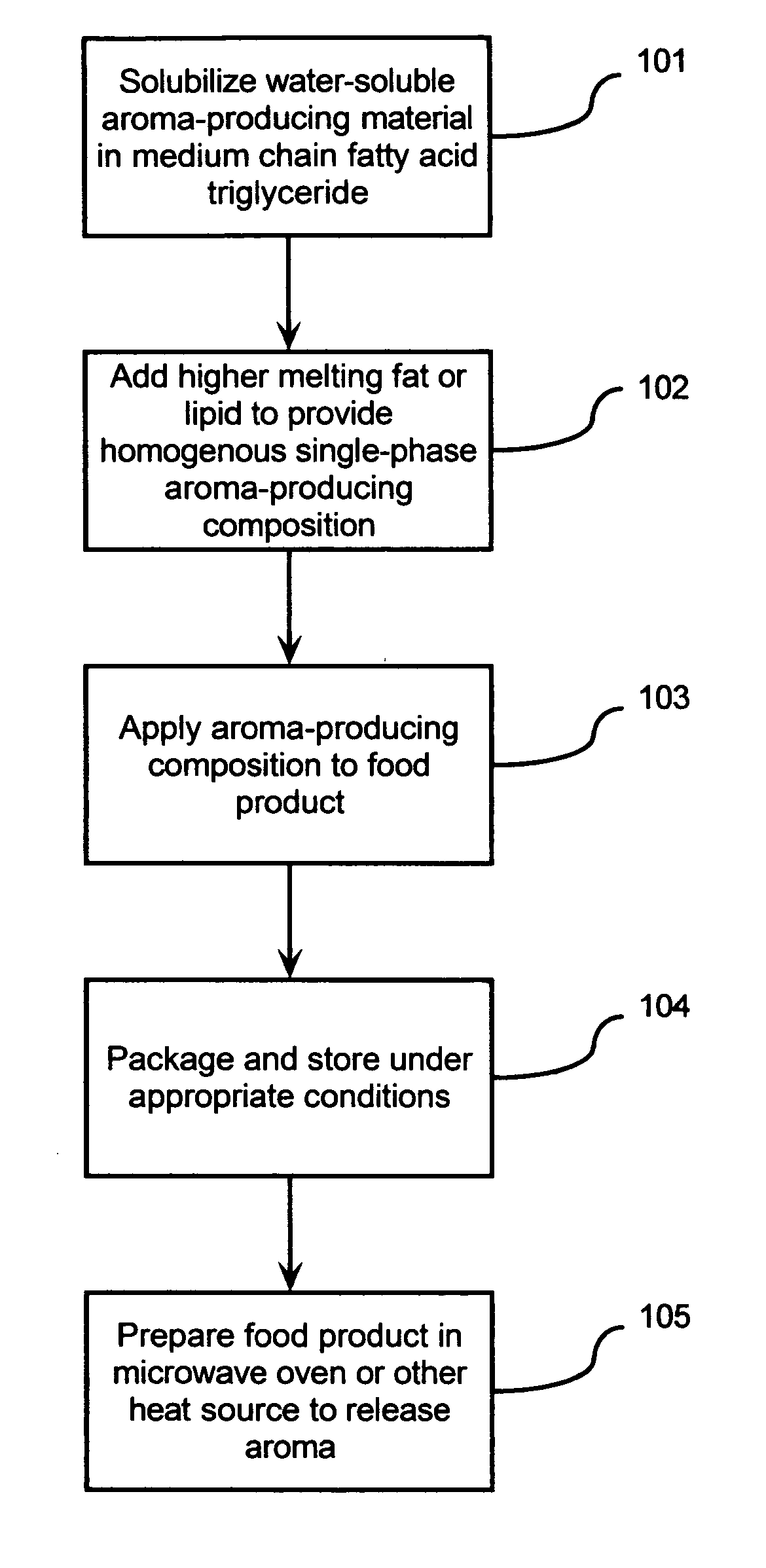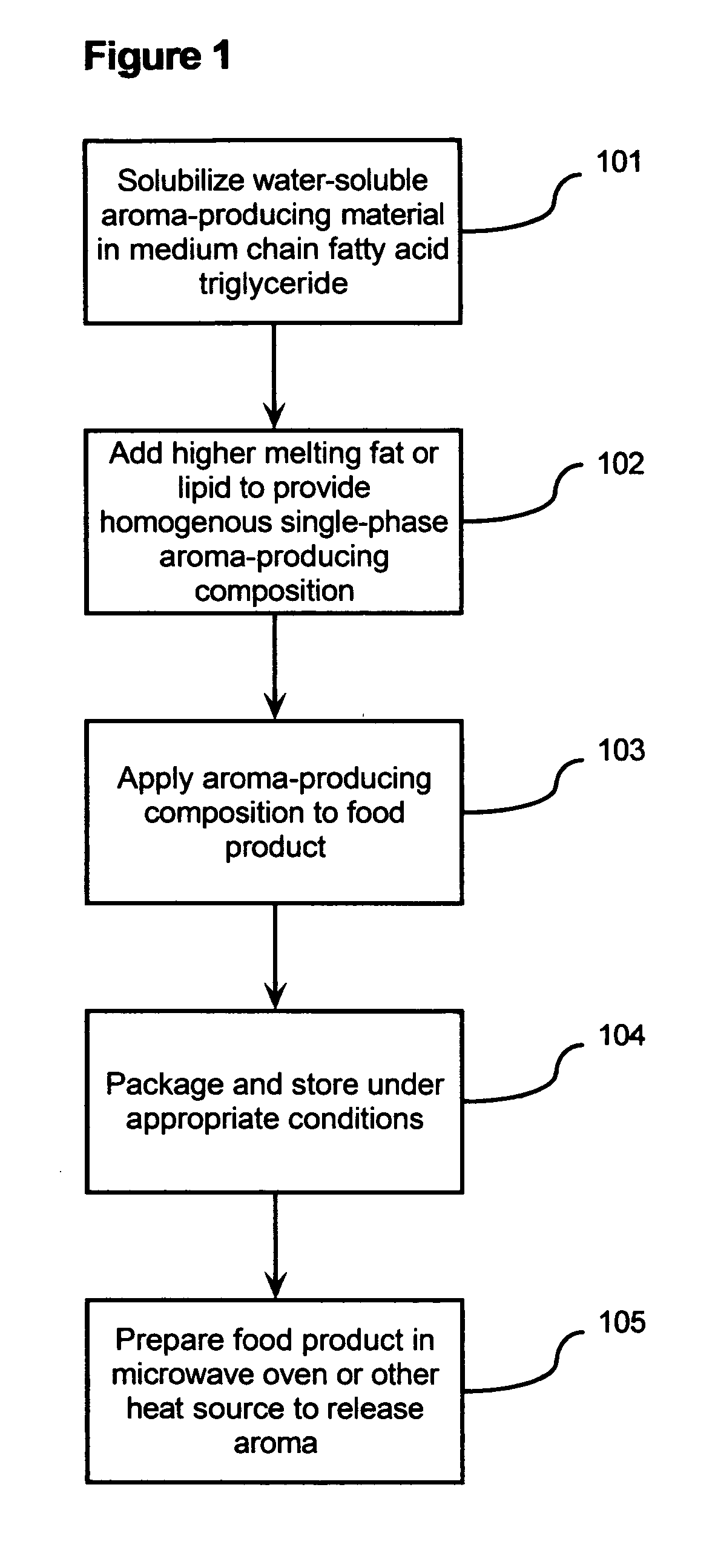Aroma-producing compositions for foods
a technology of aroma and composition, applied in the field of aroma-producing compositions, can solve the problems of unprotected flavoring materials applied on exposed outer surfaces of food products, food production costs generally increase, and aqeous phase undesirable chemical taste, and achieve the effect of rapid heat-controlled aroma release and shelf-stabl
- Summary
- Abstract
- Description
- Claims
- Application Information
AI Technical Summary
Benefits of technology
Problems solved by technology
Method used
Image
Examples
example 1
[0036] This example illustrates the aroma delivering composition of this invention for releasing cookie aroma from a cookie surface upon microwaving. The cookies used as the substrate upon which the aroma delivering composition was applied were Melting Moments® Warm 'n Serve Chocolate Chunk cookies (Christie Brown, a division of Nabisco, Toronto, ON).
[0037] A series of sprayable cookie aroma formulations 1, 2, 3, and 4 were prepared with the ingredients and respective amounts thereof indicated in Table 1. Each formulation contained artificial cookie flavor (i.e., doughy and buttery and two different types of fatty materials. The medium chain fatty acid triglyceride (fatty material #1 or “FM1” for short herein) was glycerol tridecanoate fat (Neobee® 1095 from Stepan Company, Maywood, N.J.) having a melting point of about 33° C. The higher melting point fat (fatty material #2 or “FM2” for short herein) was a hydrogenated soybean oil (Dritex® S from ACH Food & Nutrition, Paris, Ill.) ...
example 2
[0044] This example illustrates the use of aroma delivering, chocolate-flavored composition for releasing cookie aroma from a cookie surface upon microwaving. The cookies used were the same as in Example 1.
[0045] In preparing this formulation, 3 g artificial sweet chocolate flavoring (about 19 parts chocolate flavor in a carrier of about 73 parts ethanol and about 8 parts propylene glycol) was mixed with 4.2 g melted glycerol tridecanoate fat (Neobee® 1095 at about 70° C.; melting point of about 33° C.) in a vortex mixer. Melted hydrogenated soybean oil (Dritex® S; 2.8 g at about 70° C; melting point of about 70° C.) was then added to the solution and the resulting mixture was blended in a vortex mixer to form a homogenous liquid mix.
[0046] The resulting homogenous liquid mix (0.1 g) was sprayed on the cookies using an atomized form with the Dot Gun sprayer described in Example 1 (at pressure of about 2 bar and an overall speed setting of “Slow”).
[0047] The aroma release properti...
example 3
[0049] This examples illustrates the aroma delivering compositions of this invention which further include a color masking ingredient. The color masking ingredient was used to mask the white residue that can occur.
[0050] The cookies used were the same type of cookies as in Example 1. In preparing this formulation, artificial sweet chocolate flavoring (4.5 g) and yellow-brown color (0.058 g; 09089 Brown Lake dispersion, OB, Warner Jenkinson, St. Louis, Mo.) was mixed with melted glycerol tridecanoate fat (7.5 g; Neobee® 1095 at about 70° C.) in a vortex mixer. Melted hydrogenated soybean oil (3.0 g; Dritex® S at about 70° C.) was then added to the solution and the resulting mixture was blended in a vortex mixer to form a homogenous liquid mix.
[0051] The resulting homogenous liquid mix (0.1 g) was sprayed as atomized particles on each of a plurality of the cookies using essentially the same conditions for the Dot Gun sprayer as described in Example 2. For comparison, a separate batc...
PUM
 Login to View More
Login to View More Abstract
Description
Claims
Application Information
 Login to View More
Login to View More - R&D
- Intellectual Property
- Life Sciences
- Materials
- Tech Scout
- Unparalleled Data Quality
- Higher Quality Content
- 60% Fewer Hallucinations
Browse by: Latest US Patents, China's latest patents, Technical Efficacy Thesaurus, Application Domain, Technology Topic, Popular Technical Reports.
© 2025 PatSnap. All rights reserved.Legal|Privacy policy|Modern Slavery Act Transparency Statement|Sitemap|About US| Contact US: help@patsnap.com


